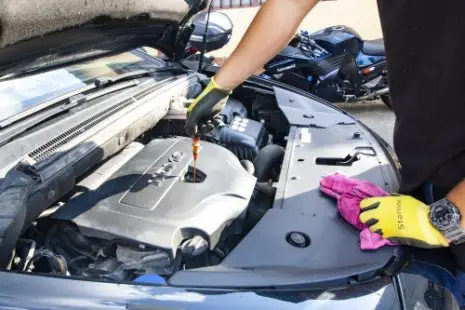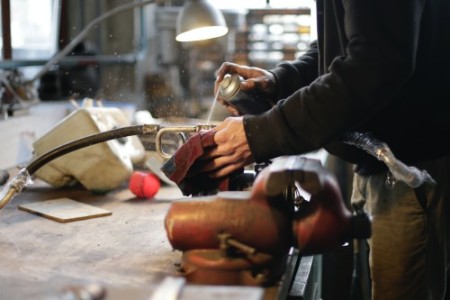A fluid leak coming from the front passenger side of your automobile might be a serious problem that has to be fixed right away. Maintaining the performance and safety of your vehicle requires knowing the type of fluid and its source.
This article will cover the typical causes of fluid leaks, how to identify the issue, what to do right away, why getting expert assistance is important, and how to make sure repairs and maintenance are completed on schedule. You may prevent additional damage and safeguard the safety of both your automobile and its occupants by taking care of this problem as soon as possible.
Identify the Fluid:
Understanding the type of fluid that has spilled is essential to determining how serious the problem is. Different fluids have unique qualities that might assist in identifying the issue:
Oil Leak:
- Color: Usually black or dark brown.
- Thick and slick in consistency.
- Burnt or oily smell in the air.
- Location: Commonly found around the engine or oil pan.
Coolant Leak:
- Usually green, pink, or orange in color.
- Watery and slippery consistency.
- Sweet and faintly chemical in scent.
- Location: Water pump, hoses, and radiator.
Transmission Fluid Leak:
- Reddish or reddish-brown in color.
- Oily and thin in consistency.
- Similar to oil in smell but somewhat sweeter.
- Location: Under the automobile or near the gearbox.
Brake Fluid Leak:
- Clear to slightly yellow in color.
- Similar to vegetable oil in consistency.
- A little bit sour and strong.
- Location: Near the brake lines, master cylinder, or wheels.

Common Causes:
Of course, the following are the typical reasons why a car’s front passenger side fluid leaks:
Oil Leak:
- Oil pan gasket that is worn or damaged.
- Worn-out valve cover gasket.
- Defective or cracked engine seals.
- Oil filter that is loose or incorrectly sealed.
Coolant Leak:
- Radiator hoses that are damaged or deteriorating.
- Radiator with corrosion or cracks.
- Defective water pump.
- Heater core leaks.
Transmission Fluid Leak:
- Worn gasket on the gearbox pan.
- Damaged input/output shaft seals on a gearbox.
- Transmission case with cracks.
Brake Fluid Leak:
- Broken or corroded brake lines.
- Brake caliper seals that are worn.
- Brake master cylinder issue.
- Brake hoses or connections that leak.
Diagnosing the Source:
A methodical approach is required to identify the cause of a fluid leak on your car’s front passenger side:
Visual Inspection:
- Put the parking brake on and position the car somewhere flat.
- Check the engine compartment for leaks by opening the hood. Look for drips, puddles, or moist or greasy areas.
- Look beneath the car, paying careful attention to the front passenger side, for any obvious fluid buildup.
Absorbent Material Method:
- Under the suspected leak region, place a sizable piece of clean cardboard or an oil absorbent pad. Overnight or for a few hours, leave the automobile parked.
- Check for any fluid spots on the cardboard or pad. You can determine the kind and source of the leak with the aid of the stains.
Fluid Characteristics:
- Check the fluid leak for color, consistency, and odor. Please refer to the “Identify the Fluid” section from earlier for instructions.
- To identify the most likely source, contrast the properties of the fluid that has spilled with the descriptions that have been given.
Professional Inspection:
It’s essential to get expert assistance if you can’t locate the leak’s source or if it’s serious.
Make contact with a skilled vehicle expert or mechanic who can do a comprehensive examination utilizing specialized tools and machinery.
Document Observations:
- Take detailed pictures of the leak site, the liquid on the ground, and any adjacent parts.
- Keep track of any further symptoms, such as adjustments to the vehicle’s performance or strange noises.

Repair and Prevention:
Once the cause of the fluid leak from your car’s front passenger side has been found, it is critical to take the appropriate remedial and preventative action:
Repair:
- The mechanic will suggest the right fixes based on the fluid type and the reason for the leak.
- To make repairs, worn or broken hoses, gaskets, seals, or other parts may need to be replaced.
- Make sure the mechanic follows the right repair techniques and only utilizes high-quality replacement components.
Maintenance and Prevention:
- Observe the suggested maintenance plan provided in the owner’s handbook for your car.
- Check your car frequently for leaks, wear, or other damage.
- Monitor your fluid intake and top it out, as necessary.
- Follow the manufacturer’s recommendations for changing fluids and filters.
- Keep an eye on the dashboard warning lights and temperature gauge in your car for any unexpected indicators.
Driving Habits:
- Avoid driving in a harsh manner that might wear down your car’s parts.
- To avoid harming the undercarriage, take care when driving over potholes or uneven terrain.
Temperature Control:
- By immediately correcting cooling system concerns, protracted engine overheating may be prevented.
- Use engine coolant with a higher boiling point if your car is prone to overheating.
Proper Fluids:
- Use the fluids that the vehicle’s manufacturer has specified are the right type and grade.
- Make sure that all fluid levels are correct to avoid putting extra strain on components.
Timely Repairs:
- Any faults should be resolved right away to avoid minor difficulties turning into expensive fixes.
- Check your car frequently and fix any leaks or other issues as soon as you notice them.
Regular maintenance:
To guarantee the best health and durability for your car, routine maintenance is essential. You can aid in preventing leaks and preserving optimal engine performance by periodically monitoring and replacing necessary fluids including oil, coolant, brake fluid, and gearbox fluid. Replacement of air and cabin filters regularly encourages clean air intake and improves efficiency. Tyre maintenance techniques include rotating, balancing, and maintaining the proper pressure not only increasing Tyre life but also improving fuel economy and handling.
Regular belt and hose inspection helps avoid unplanned failures, and careful brake maintenance, which includes checking fluid levels and addressing pad wear, offers dependable stopping power. An effective cooling system that receives regular coolant tests and leak repair protects against overheating and potential leaks. Following the manufacturer’s advised service intervals and performing electrical and exhaust system inspections are other factors that improve a vehicle’s performance, increasing safety and dependability while driving.
Frequently Asked Questions (FAQs):
What may be dripping from the car’s front passenger side?
Engine oil, coolant, gearbox fluid, brake fluid, power steering fluid, and even windscreen washer fluid might be flowing from a car’s front passenger side.
Why is the front passenger side of my automobile dripping with a clear fluid?
Water condensation from the air conditioning system or windscreen washer fluid may be flowing from the front passenger side of your car.
Where does the car’s AC leak?
Leaks in the evaporator core, condenser, refrigerant lines, compressor seals, fittings, and connections can occur in the vehicle’s air conditioning system.
Why does my AC leak on the floor of the passenger side?
A clogged or blocked condensate drain is a common reason for AC leaks on the passenger side floor. Condensation is created by the air conditioning system when it cools the air, and this moisture is typically drained away. Water might build up and flow into the passenger compartment if the drain becomes blocked.
Conclusion:
In conclusion, you must take a proactive and methodical approach to fix a fluid leak coming from the front passenger side of your car. The first step in rectifying the problem is to determine the fluid type and its source, whether it is brake, gearbox, or coolant fluid. Knowing typical reasons like worn gaskets, cracked hoses, or defective seals might help with fixes. Swift action helps prevent more harm and promotes safety. Examples include parking sensibly, utilizing absorbent materials, and refraining from driving.
For precise diagnosis and repairs that preserve the integrity of your car, see a qualified technician. Regular maintenance procedures, such as oil changes, fluid level checks, filter replacements, and inspections of critical components, are crucial for keeping your car in good overall condition and preventing further leaks. You can drive with confidence knowing that you are protecting both the performance of your car and your safety on the road by following these recommendations and taking a proactive approach to vehicle maintenance.

